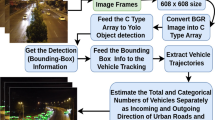Abstract
A model-based vehicle tracking system for the evaluation of inner-city traffic video sequences has been systematically tested on about 15 minutes of real world video data. Methodological improvements during preparatory test phases affected—among other changes—the combination of edge element and optical flow estimates in the measurement process and a more consequent exploitation of background knowledge. The explication of this knowledge in the form of models facilitates the evaluation of video data for different scenes by exchanging the scene-dependent models. An extensive series of experiments with a large test sample demonstrates that the current version of our system appears to have reached a relative optimum: further interactive tuning of tracking parameters does no longer promise to improve the overall system performance significantly. Even the incorporation of further knowledge regarding vehicle and scene geometry or illumination has to cope with an increasing level of interaction between different knowledge sources and system parameters. Our results indicate that model-based tracking of rigid objects in monocular image sequences may have to be reappraised more thoroughly than anticipated during the recent past.
Similar content being viewed by others
References
Ferryman, J.M., Worrall, A.D., Sullivan, G.D., and Baker, K.D. 1997. Visual surveillance using deformable models of vehicles. Robotics and Autonomous Systems, 19:315–335.
Ferryman, J.M., Maybank, S.J., and Worrall, A.D. 1998. Visual surveillance for moving vehicles. In Proc. IEEE Workshop on Visual Surveillance, Bombay, India, pp. 73–80.
Frank, Th., Haag, M., Kollnig, H., and Nagel, H.-H. 1996. Tracking of occluded vehicles in traffic scenes. In Proc. Fourth European Conference on Computer Vision, Cambridge, UK, Lecture Notes in Computer Science 1065, Springer-Verlag, Berlin, Heidelberg 1996, pp. 485–494.
Gardner, W.F. and Lawton, D.T. 1996. Interactive model-based vehicle tracking. IEEE Transactions on Pattern Analysis and Machine Intelligence, 18(11):1115–1121.
Haag, M. and Nagel, H.-H. 1998a. Tracking of complex driving manoeuvers in traffic image sequences. Image and Vision Computing, 16(8):517–527.
Haag, M. and Nagel, H.-H. 1998b. Beginning a transition from a local to a more global point of view in model-based vehicle tracking. In Proc. Fifth European Conference on Computer Vision, Freiburg, Germany, Lecture Notes in Computer Science 1406, Springer-Verlag, Berlin, Heidelberg, New York 1998, pp. 812–827.
Heimes, F., Nagel, H.-H., and Frank, Th. 1998. Model-based tracking of complex innercity road intersections. Mathematical and Computer Modelling, 27(9–11):189–203.
Kanade, T. 1978. Region segmentation: Signal vs. semantics. In Proc. 4th International Joint Conference on Pattern Recognition, Kyoto, Japan, pp. 95–105.
Koller, D., Daniilidis, K., and Nagel, H.-H. 1993. Model-based object tracking in monocular image sequences of road traffic scenes. International Journal of Computer Vision, 10(3):257–281.
Kollnig, H., Nagel, H.-H., and Otte, M. 1994. Association of motion verbs with vehicle movements extracted from dense optical flow fields. In Proc. 3rd European Conference on Computer Vision, Stockholm, Sweden, Lecture Notes in Computer Science 801, Springer-Verlag, Berlin, Heidelberg, New York 1994, pp. 338–347.
Kollnig, H. and Nagel, H.-H. 1995. 3D pose estimation by fitting image gradients directly to polyhedral models. In Proc. International Conference on Computer Vision, Cambridge, MA, pp. 569–574.
Kollnig, H. and Nagel, H.-H. 1996. Matching objects to segments from an optical flow field. In Proc. 4th European Conference on Computer Vision, Cambridge, UK, Lecture Notes in Computer Science 1065, Springer-Verlag, Berlin, Heidelberg 1996, pp. 388–399.
Kollnig, H. and Nagel, H.-H. 1997. 3D pose estimation by directly matching polyhedral models to gray value gradients. International Journal of Computer Vision, 23(3):283–302.
Maybank, S.J., Worrall, A.D., and Sullivan, G.D. 1996a. A filter for visual tracking based on a stochastic model for driver behaviour. In Proc. Fourth European Conference on Computer Vision, Cambridge, UK, Lecture Notes in Computer Science 1065, Springer-Verlag, Berlin, Heidelberg 1996, pp. 540–549.
Maybank, S.J., Worrall, A.D., and Sullivan, G.D. 1996b. Filter for car tracking based on acceleration and steering angle. In Proc. 7th British Machine Vision Conference, Edinburgh, UK, pp. 615–624.
Mitiche, A. and Bouthemy, P. 1996. Computation and analysis of image motion: A synopsis of current problems and methods, International Journal of Computer Vision, 19(1):29–55.
Nagel, H.-H. and Haag, M. 1998. Bias-corrected optical flow estimation for road vehicle tracking. In Proc. Sixth International Conference on Computer Vision, Bombay, India, pp. 1006–1011.
Otte, M. and Nagel, H.-H. 1995. Estimation of optical flow based on higher-order spatiotemporal derivatives in interlaced and noninterlaced image sequences. Artificial Intelligence, 78(1/2):5–43.
Sullivan, G.D., Worall, A.D., and Ferryman, J.M. 1995. Visual object recognition using deformable models of vehicles. In Proc. IEEE Workshop on Context-Based Vision, Cambridge, MA, pp. 75–86.
Sullivan, G.D., Baker, K.D., Worall, A.D., Attwood, C.I., and Remagnino, P.M. 1997. Model-based vehicle detection and classification using orthographic approximations. Image and Vision Computing, 15(8):649–654.
Tan, T.N., Sullivan, G.D., and Baker, K.D. 1996. Efficient gradientbased object localisation and recognition. In Proc. IEEE Conference on Computer Vision and Pattern Recognition, San Francisco, CA, pp. 397–402.
Tan, T.N., Baker, K.D., and Sullivan, G.D. 1997. Model-independent recovery of object orientations. IEEE Transactions on Robotics and Automation, 13(4):602–606.
Tan, T.N., Sullivan, G.D., and Baker, K.D. 1998. Model-based localisation and recognition of road vehicles. International Journal of Computer Vision, 27(1):5–25.
Tonko, M., Schäfer, K., Heimes, F., and Nagel, H.-H. 1997. Towards visually servoed manipulation of car engine parts. In Proc. IEEE International Conference on Robotics and Automation, Albuquerque, NM, pp. 3166–3171.
Author information
Authors and Affiliations
Rights and permissions
About this article
Cite this article
Haag, M., Nagel, HH. Combination of Edge Element and Optical Flow Estimates for 3D-Model-Based Vehicle Tracking in Traffic Image Sequences. International Journal of Computer Vision 35, 295–319 (1999). https://doi.org/10.1023/A:1008112528134
Issue Date:
DOI: https://doi.org/10.1023/A:1008112528134




